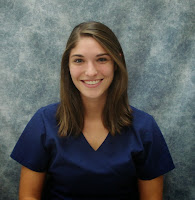Do you have a cat that doesn't always use the litter box? Are you frustrated with your feline friend? Click on the link below for some information that might be of help.
What To Do About Common Urinary Problems in Cats | petMD
The professional staff at Kaukauna Veterinary Clinic uses this blog as a way to promote responsible pet ownership by sharing preventative health care and health-related educational articles.
Tuesday, October 22, 2013
Monday, October 21, 2013
Subcutaneous Fluids (SQ) for Dogs and Cats
Some clients find it easier to administer fluids at home versus bringing their pet in for frequent visits to the veterinary clinic. Cats especially do not like car rides or going to the vet and giving fluids at home reduces their stress. If you ever need to do this with your pet, this is a nice how to video.
Monday, October 14, 2013
Kaukauna Vet Celebrates National Veterinary Technician Week
Meet Our Techs!
LICENSED VETERINARY TECHNICIANS
Students in the veterinary technology program are taught the skills and procedures to effectively contribute to the health and well being of veterinary patients. Veterinary technicians, while always working under the supervision of a veterinarian, provide many services. Routine duties include restraint of animals, sample collection, nursing care (IV catheter placement, bandage application, medication administration, etc.), feeding of animals, record keeping, office procedures, and client education and communication. Other skills include administration of anesthesia, surgical nursing, radiographic procedures, dental prophylaxis, clinical pathology procedures and medication preparation.
After graduation, all of our technicians passed the Veterinary Technician National (or State) Exam. Receiving a passing score permits the use of the title of Certified or Licensed Veterinary Technician.

Diane, LVT
Diane graduated from the Medical
Institute of Minnesota in 1981 and
started
working with us in 1982.
|

Tricia, LVT
Tricia graduated from Madison Area
Technical College in 1993 and
started working with
us in 1998.
|
|

Melinda, LVT
Melinda graduated from the Medical
Institute of Minnesota in 2001 and
started
working with us after graduation.
|

Reina, LVT
Reina graduated from Globe University
located in Minnesota in 2005 and started
working with us in 2009.
| |

Anita, LVT
Anita graduated from North Dakota
State University in 1986 and started
working with us in March of 2012.
|

Nicole, LVT
Nicole started working at the clinic in 2011
as kennel staff while she attended
Globe
University in the veterinary
technician
program. She graduated in the fall
of 2012.
|
LANA, LVT
Lana graduated from Madison College
in 2012 and started working for us
May of 2013.
|
Sunday, October 13, 2013
Kaukauna Vet Celebrates National Veterinary Technician Week
National Veterinary Technician Week
October 13th-19th, 2013
October 13th-19th, 2013
“Your Trusted Partner in Lifelong Care”
It was 21 years ago that the U.S. Congress voted to declare
the third week of October, National Veterinary Technician Week (NVTW). With
this act Veterinary Technicians, the preeminent pet nurses working in the
treatment area of the veterinary hospital, were celebrated for the tireless
work they perform as advocates for animals and caretakers for hospitalized
pets.
The week-long celebration, with sponsorship from the
National Association of Veterinary Technicians in America (NAVTA), Hill’s Pet
Nutrition, Partners for Healthy Pets, and the Ontario (Canada) Association of
Veterinary Technicians, seeks to elevate public awareness of the importance of
the veterinary nursing staff. Veterinary Technicians work throughout animal
clinics and hospitals providing nursing care, patient assessment, and surgical
assistance. Additionally, veterinary technicians work as radiography
technicians, dental hygienists, client communicators, educators, medical
laboratory technicians, and often as hospital and practice managers.
This year’s theme for NVTW is: “Your Trusted Partner in
Lifelong Care” as advocates for pet health Veterinary Technicians believe an
ounce of prevention is worth a pound of cure.”
“The Credentialed Veterinary Technician is so much more than an
assistant to the Doctor of Veterinary Medicine.” said Dennis Lopez, M.Ed., LVT,
and 2013 President of NAVTA. “The public
is often uninformed about the importance of the veterinary nursing staff behind
the scenes, working long shifts in the treatment rooms of animal clinics and
hospitals. Our view at NAVTA is that the Veterinary Technician is an extension
of the Doctor, performing many critical nursing tasks in support of patient
care.”
Following a series of legislative changes culminating in
2010, credentialed veterinary technicians (Certified, Registered, or Licensed),
are now required to graduate with a minimum of a two-year Associate Degree,
perform many hours of clinical externship, and pass the Veterinary Technician
National Examination (VTNE) before being allowed to practice. “Credentialed
technicians really are the equivalent of a human Registered Nurse,” stated
Lopez. “They go through a science heavy education, learn and experience a wide
variety of skills, and then have to pass a very difficult national board exam.
However, unlike human medical professionals, the Veterinary Technician must
learn the anatomy, disease process, patient care, and nursing skills to
practice on 20 – 30 species. The education and ability to practice is very
rigorous.” Most states require the Credentialed Veterinary Technician to
maintain continuing education hours and to stay on the cutting edge of
veterinary medicine.
The National Association of Veterinary Technicians in
America is a nonprofit organization that represents and promotes the profession
of Veterinary Technology. NAVTA provides
direction, education, support and coordination for its members. Incorporated in 1981, NAVTA is the national
organization devoted exclusively to developing and enhancing the profession of
veterinary technology. For more information about NAVTA, visit their website at www.navta.net .
Subscribe to:
Comments (Atom)


